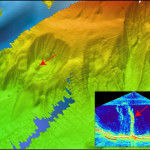
A placoderm fossil called “mother fish” has been recovered from Gogo, an ancient coral reef site off the Kimberley coast of Northwest Australia. The fossil was recovered with embryo and umbilical cord still attached, providing evidence of live birth and sex with penetration in the Middle Paleozoic Era, 200 million years before it was ever thought possible. This remarkable finding shows that egg-laying and live-birth evolved together, rather than sequentially.
The tail-first birthing process was probably similar to that of some species of sharks and rays living today, says the study, published Thursday in the British journal Nature.
Read more here at Discovery News and here at Reuters






I love it that this amazing find happened on a whim:
“John and I were just going to write up the fish, describe it anatomically,” she recalled in a phone interview. “But we decided to give it one last acid bath to see if we could expose more of the shoulder from the rock.”
Makes me wonder how many things are discovered because people decide “what the heck, let’s do it.”
And many things are not discovered because people decide “forget it, it’s my lunch break.”
A good scientist lets curiousity do the driving! I’ve made discoveries that way as well. Just taking the time to look at stuff, for long periods of time.
and here we thought the kiddie-harness was a new thing…
First ROV discovered…